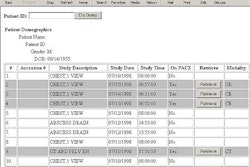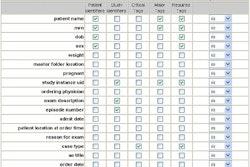BOSTON - It's been said that change is constant, but in today's world, change is accelerating exponentially, according to Raymond Kurzweil, founder, chairman, and CEO of Kurzweil Technologies. Kurzweil believes that the accelerated pace of change will foster a blending of biological and non-biological intelligence, and trigger an explosion of human knowledge.
Kurzweil, who gave the keynote address at the opening session today of the 20th Symposium for Computer Applications in Radiology in Boston, said that growing understanding of the human brain will lead to a future in which non-biological technologies such as intelligent nanobots augment our natural human intelligence.
"Because of the explosive power of exponential growth, the 21st century will (see) a thousand times greater (progress) than the 20th century, which was no slouch for change," Kurzweil said. An inventor of computer-based speech recognition technology, Kurzweil also authored a bestselling book in 1999, The Age of Spiritual Machines, When Computers Exceed Human Intelligence.
Some predict that adoption of 3-D molecular computing technology will produce enough computing power to emulate the human brain by 2020, Kurzweil said. Of course, that depends on the ability to fully understand brain functions such as viewing intelligence, wisdom, and emotional intelligence.
"We can't see inside (the brain) yet with sufficient resolution and speed to actually see what's going on, to fully reverse-engineer the brain yet," he said. "But if we look at the pace of progress in terms of the technologies that are coming down, that are now in development, I believe it's a conservative projection that we will be able to reverse-engineer the brain within 25 years."
Resolution for noninvasive brain scanning has essentially been doubling every year, and image reconstruction has been doubling every 18 months. But with MRI and CT scans, it's still not possible to see high enough resolution to see individual elements, he said.
At institutions such as the University of Pennsylvania and others, researchers are working to develop the next generation of brain imaging tools, which will enable the visualization of individual signaling. This generation is expected to be operational within two or three years, he said.
"As we can see finer and finer resolutions both in time and space, we will be able to see inside the human brain and actually see what's going on," he said.
Kurzweil predicts that computers will disappear by 2010, and images will be written directly onto our retinas. Ubiquitous high-bandwidth Internet connections will be available at all times, and tiny electronics will be embedded in areas such as the environment, clothing, and eyeglasses, he said.
Full-immersion audiovisual virtual reality will be possible, as well as augmented "real" reality. Kurzweil also envisions increased interaction with virtual personalities, and communicated during his talk with Ramona, an avatar or virtual personality, from his Web site, kurzweilAI.net.
Nanotechnology will be ubiquitous by the 2020s, Kurzweil said. By 2029, an "intimate" interconnection between non-biological intelligence and human's biological intelligence will be achieved, Kurzweil said.
And by the time that happens, $1,000 worth of computing power will wield 1,000 times the power of the human brain, he said. Reverse-engineering of the human brain will be completed, and computers will be able to operate at human levels.
Non-biological intelligence combines the subtlety and pattern-recognition strength of human intelligence, with the speed, memory, and knowledge-sharing of machine intelligence, Kurzweil said.
"Non-biological intelligence will continue to grow exponentially, whereas biological intelligence is effectively fixed," he said.
The use of intelligent nanobots will provide noninvasive, surgery-free neural implants that can be distributed to millions or even billions of points in the brain, Kurzweil said. This will lead to expansion of human intelligence, multiplying the natural 100 trillion connections of the brain many times over.
Today, neural implants require surgical insertion. But Kurzweil sees the eventual deployment of nanobots into the bloodstream, reacting noninvasively with neurons.
Within a decade, human life expectancy could be growing by a year every year, thanks to advances in biotechnology and systems that tackle underlying human disease, Kurzweil said.
By Erik L. RidleyAuntMinnie.com staff writer
June 7, 2003
Copyright © 2003 AuntMinnie.com




















